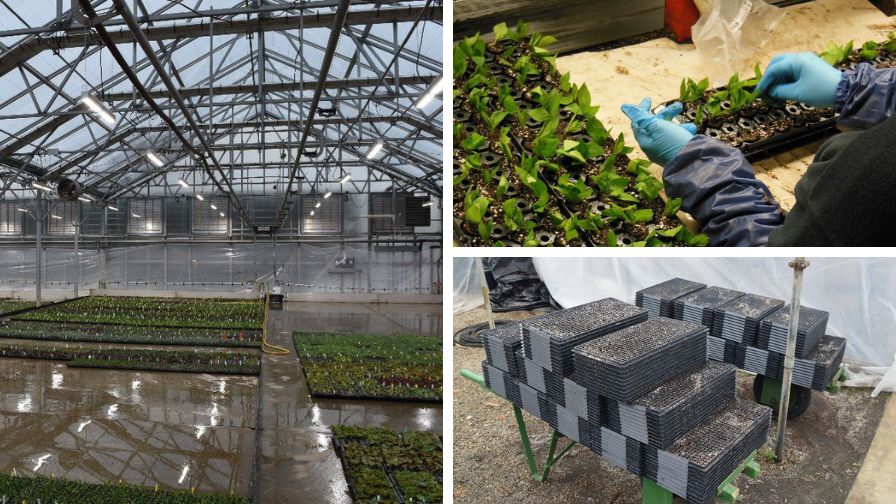
(Clockwise from left) A clean and well-maintained propagation greenhouse, a greenhouse employee wearing disposable gloves while handling and sticking unrooted cuttings, and propagation trays stacked on top of each other and pressed together to dibble each cell. This reduces substrate aeration and is not a best management practice. | W. Garrett Owen, OSU
One critical aspect of greenhouse production is the propagation of unrooted cuttings (URCs). In a recent e-Gro Alert, W. Garrett Owen of The Ohio State University covered the best practices for growers to optimize their propagation process, leading to healthy crops and an efficient workforce.
1. Sanitation: The Foundation of Healthy Propagation
Warm conditions are good for rooting, but also create an ideal environment for pathogens to quickly spread. Therefore, maintaining a clean environment is crucial for the propagation of URCs.
Owen recommends “cleaning and disinfecting all surfaces that will come into contact with cuttings,” including benches, floors, trays, tools, and storage containers. He also notes that special attention should be placed on irrigation system equipment, such as mist nozzles, where pathogens can be stored and easily spread to cuttings through watering.
Lastly, all workers should abide by a hand-washing protocol before handling any cuttings. Disposable gloves can also be used as an extra precaution, though should be changed out when handling different cuttings to prevent cross-contamination.
2. Handling Upon Arrival: Timing is Everything
Unrooted cuttings are living plant material, and, therefore, can be damaged or deteriorate quickly if improperly handled. To reduce this risk, URCs should be planted ASAP upon arrival. Owen says that means “having propagation media prepared, trays ready, and staff on hand to begin the sticking process without delay.”
However, before planting, all deliveries should be inspected to ensure quality. Potential issues that can affect successful propagation that should be checked include:
- Diameter
- Length
- Leaf number and size
- Signs of damage
- Signs of disease
- Signs of stress
- Signs of wilting
Additional aspects of quality control that should be addressed are making sure everything is labeled properly, and that URCs are delivered at an appropriate temperature.
3. Preparation: Setting the Stage for Callusing and Rooting Success
Preparation starts with your selection of a substrate. Owen recommends “selecting a high-quality, pathogen-free propagation substrate that provides adequate aeration and water retention. The ideal substrate should have a balance of large and small pores for aeration and to support both root growth and water management.”
Substrates should be evenly moist, not too wet or dry, when placed in pre-dibbled propagation trays. Owen recommends that staff dibble holes in trays using a metal tool that can be sanitized to maintain aeration.
The use of rooting hormones can be considered for plant species that are notoriously for rooting difficulties, such as auxin-based compounds, particularly indole-3-butyric acid (IBA). Applications methods include powder, liquid drip, and foliar spray.
4. The Sticking Process: Precision & Care
Owen organizes the sticking process into the following categories:
- Training and technique: Maintaining a balance between speed and precision when sticking unrooted cuttings. Staff should be able to demonstrate the correct sticking depth depending on the cutting size, allowing the URC to stand upright. Quality checks should also be performed regularly to maintain high standards.
- Gentle handling: As was the case in Step 2, handling is critical. Staff should be trained to hold cuttings by the stem to avoid damage and disease spread. In relation to cutting depth, the right amount of pressure must be applied when inserting a cutting into the substrate to ensure successful contact.
- Workflow optimization: Efficiency and worker productivity and be maintained without sacrificing quality control. Workflows should be organized to prevent unnecessary movement of workers and URCs, providing everything of need within easy reach.
- Post-sticking care: The job is not done once the cutting is in place. Once a pot or tray is filled, it should be placed “in a high humidity environment such as a plastic covered cart or under mist to prevent wilting.” The cutting should then be monitored closely over the next 24 to 48 hours, with misting applied as needed to maintain turgidity.
5. Environmental Control: Nurturing Root Development
Successful propagation of unrooted cutting to promote rooting requires the following care:
- Carbon dioxide and air circulation
- Humidity and Vapor Pressure Deficit (VPD) control
- Lighting control
- Monitoring and adjustment
- Temperature management
For more information on these environmental control methods and additional insights on unrooted cutting propagation best practices, please read the full e-Gro (Electronic Grower Resources Online) alert “Rooting for Success: Best Practices in Unrooted Cutting Propagation.” Additional and current e-Gro alert pieces from Volume 14 (2025) can be found online.

